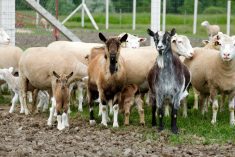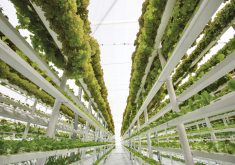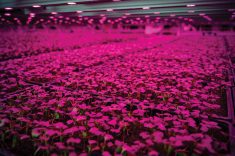A prominent Calgary landmark will soon be the site of a large indoor aeroponics farming operation.
About 65,000 square feet of former second-floor office space at the Calgary Tower Centre is being converted into a vertical farming operation that will grow strawberries, cucumbers, tomatoes, leafy greens and melons.
“The produce we’re really interested in growing is the fruit and berry varieties that we are playing with right now because those are largely not grown here at all,” said Dan Houston, president of Agriplay Ventures, a Calgary company that aims to convert “under-utilized commercial real estate” into vertical farms.
“But ultimately what we are trying to do is basically supplement everything that we can grow that isn’t being grown locally to stabilize our local food supply.”

Aeroponic farming doesn’t use a growth medium like other forms of hydroponics, said Houston. Roots are left exposed and are continually misted with nutrient-rich water.
The key advantage of indoor farming is the ability to grow continuously in a controlled environment, he said.
“Imagine the most amazing farmer who knows everything — like she almost has a psychic connection to what she is growing,” he said. “Much of what makes a good crop is completely out of her control because it’s entirely under the control of the environment. When we separate ourselves from the environment, that stability is maintained. I never have to worry about a bad crop because all the inputs are controlled.”
Indoor farming also allows for creativity, particularly with lighting and temperature, said Houston, adding it’s possible to make plants grow faster with high yields compared to conventional farming. Aeroponics can produce three to five times more crop in about one-tenth of the space with a 98 per cent reduction in water use, he said.
Read Also

Moo translator and methane measures: There’s an app for that
Dalhousie University researchers use artificial intelligence to create new dairy farm apps that analyze cattle sounds and measure methane.
“The other side is we don’t need to spray. We don’t need anything else because if you eliminate the soil, and provide nutrients based on the actual nutrient solution, you’ve got a sterile medium, and our rooms are basically treated as clean rooms. There’s really no vector for the transmission of any pests. That’s one of the ways to control your stability.”
Agriplay’s technology is highly automated, and flexibility is the name of the game — nutrients are controlled depending on what’s being grown at any given time.
“You don’t need to be a 20-year veteran of horticulture to be able to plan this,” said Houston, a veteran of the commercial real estate sector. “You can basically come off the street (and run it). Our largest expense is probably going to be people, then our automation practices will kick in probably by the end of Q1 next year. That allows us to augment the labour so we can grow more food with the same amount of people.”

Houston said downtown Calgary’s office vacancy rate is as high as 50 to 60 per cent — not the frequently used figure of 35 per cent — and converting that space is cheaper than building a major commercial facility. Since the technology his company uses is modular, it can be installed in a variety of settings and locations, he said.
“You can take advantage of existing infrastructure that you don’t have to pay for, and then effectively retrofit it so that every local community can grow what they need, and specifically for farmers in the area, you’re not coming in and taking over something they are already trying to grow.”
Indoor farming typically has high start-up and operating costs but it also has advantages, said Robert Spencer, a horticulture instructor at Olds College.
“The benefits are you can fine-tune everything,” said Spencer. “And you can maximize productivity in a small area and multiply that productivity in terms of multiple crops and multiple layers. But the cons are the costs.”
The key to indoor farming success is finding the sweet spot between crop needs and available space, he said.
“Typically, in an indoor farming space you are looking at short, rapid maturing crops where you can pound out a lot of crops at once or you can have multiple harvests and they don’t take up a huge amount of space,” he said. “It’s highly water efficient and can be very productive.
“We are going to continue to see indoor farming evolve because we’ve got all this empty urban space.”















